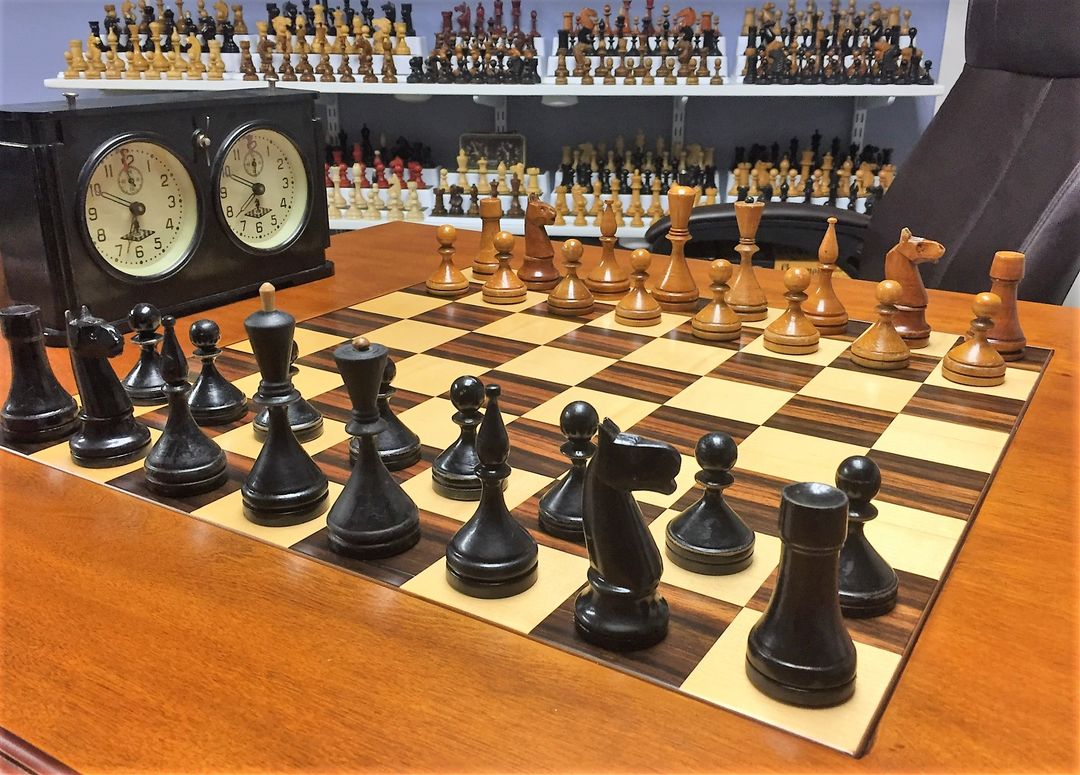Collectors of Soviet chess sets are familiar with the pieces that have come to have been known as “Baku” chessmen so-named by Western collectors because the photographic record establishes that they were used in the 1961 Soviet Championship held in Baku, Azerbaijan SSR. The name raised eyebrows among collectors in the former SSRs, who typically refer to otherwise unnamed sets by where they were produced, because they understood the pieces to have been manufactured in the Leningrad region.

The design is well-liked among collectors. Noted American collector Mike Ladzinski names it his favorite Soviet design: “These pieces exude a wonderful board presence. I love the unique Bishops, those whimsical Knights, the wide base Pawns with big ball heads, and the stocky Rooks along with the wonderful Kings and Queens with BFII elements.” The kings range in size around 110 mm and appear in a variety of finishes. Here is a set from Ron Harrison’s collection with blond White pieces like those shown in the Tal photo above.

A red-orange specimen resides in my collection. It came with a board stamped Red Combine bearing a hand-written gift inscription “In memory of Yuri, from relatives,” and “1951” inside the box. While I don’t think that Red Combine manufactured the pieces, I do think the board is contemporaneous to the pieces, and is evidence of their dating.

Here are two other specimens from my collection.


The pieces exude modernist design influences, combining them with a twist of Ancient Rus. The base and stems have been simplified into a single conical structure, which after a tapering ascent flairs out to form pedestals upon which the piece signifiers rest. The royals’ piece signifiers are attached to the pedestals by a double collar connector, reminiscent of basic Staunton design. The sweeping, curved tower walls of the rooks rhyme with the base and stem structures of the royals, clerics, and pawns. The knights are simply carved and tubular, bearing a striking resemblance to an early 15th century horse unearthed in an archaeological dig of ancient Novgorod, which I like to describe as “Novgorod Knight.”

Inasmuch as the dig occurred after the Baku first appeared, I cannot claim that they were directly copied. The connection may exist in the recesses of the collective unconscious of Russian art, a topic for another day.
The three sets that I have reweighted all came with cavities stuffed with a combination of glue and sawdust that reeked when drilled.
While variations in piece heights, base widths and structure, finishes, and snout sizes are observable, I don’t find them significant or systematic enough to merit any sub-genuses of the design, with one exception. Some sets contain faceted knight bereft of the simple mane carvings found on the tubular knights. Here is an example.

While it seems clear that the faceted knights are a simplification of the main design inasmuch as they are easier and quicker to make, I don’t find that there is direct evidence at this time sufficient to say whether the faceted design or the tubular one came first. But I do find some compelling circumstantial morphological evidence probative of the issue. Consider this set, commonly known to collectors as the BFII Penguin Knight set owing to the shape of the knight. It appears in the photographic record right about 1940.

The unitary conical base-stem-pedestal configuration of the Penguin Knight set is virtually identical to that of the Baku sets. The knight shares the same Novgorodian form. Even the facial carvings appear similar. The royals’ piece signifiers are very close in shape to those of the Bakus. The Penguin Knight’s bishop has an altogether different miter, and is attached by a double-collar connector that has disappeared in the Bakus even as it remained in the Baku royals. The Penguin Knight’s rook is a typical, straight-walled BFII rook characteristic of BFII sets from the 1930s and later, whereas the Baku rook’s walls are curved to repeat the general shapes of the royals, clerics, and pawns. I infer from this that the Baku design derived from the Penguin Knight BFII some time after 1940. Further research may shed some light on this morphological relationship.
Already St. Petersburg collector and researcher Sergey Kovalenko has tied the Baku design to the early- to mid- 1950s. Here are two photos Sergey dissects.


Writes Sergey:
New label. “White Baku” chessmen with the “native” board. By “native” I mean same period board. Both artels (“Древпром” and “Лужский мебельщик”) from Leningrad region. According to accounting documents located in the archives of the Leningrad region, the “Drevprom” artel produced two types of chess and many other wood products, with the exception of chess boards. The “Luzhskiy Mebel’shik” artel produced a lot of wooden furniture, as well as chess boards, but did not produce chess. It is worth noting that the situation could change over time. The documents viewed in the archive relate to the period 1953-1956.
Russian Chess Sets (Tsarist, Soviet and Modern), 14 November 2022.
Sergey’s research is supported by the emergence of at least one Baku specimen in an original cardboard box from Artel Drevprom. Graphic images of the Baku pieces appear on the box’s cover.


Artel Drevprom’s Baku set is a much-loved design with ties to Old Rus, the renaissance of chess set design in the Soviet Union of the 1930s, and the dominant chess played at the highest levels of Soviet competition.

